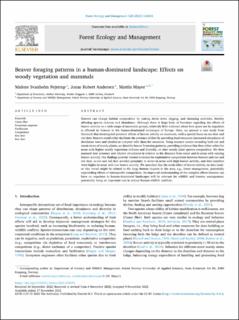| dc.contributor.author | Svanholm Pejstrup, Malene | |
| dc.contributor.author | Andersen, Jonas | |
| dc.contributor.author | Mayer, Martin | |
| dc.date.accessioned | 2024-04-10T06:25:27Z | |
| dc.date.available | 2024-04-10T06:25:27Z | |
| dc.date.created | 2023-02-02T14:22:55Z | |
| dc.date.issued | 2023 | |
| dc.identifier.citation | Forest Ecology and Management. 2023, 528 | en_US |
| dc.identifier.issn | 0378-1127 | |
| dc.identifier.uri | https://hdl.handle.net/11250/3125624 | |
| dc.description.abstract | Beavers can change habitat composition by cutting down trees, digging, and damming activities, thereby affecting species richness and abundance. Although there is large body of literature regarding the effects of beaver activity on a wide range of taxonomic groups, relatively little is known about how space use by ungulates is affected by beavers in the human-dominated landscapes of Europe. Here, we present a case study from Denmark that investigated potential effects of beaver activity on mammals, with a special focus on roe deer and red deer. Beavers could either facilitate the presence of deer by providing food resources (increased abundance of deciduous trees and shrubs) or compete with them for resources. Using transect counts recording both cut and uncut stems of woody plants, we describe beaver browsing patterns, providing evidence that they either select for areas with higher woody vegetation richness and diversity, or alter woody plant species composition. We then assessed deer presence and relative abundance in relation to the distance from water and in areas with varying beaver activity. Our findings provide limited evidence for exploitative competition between beavers and roe and red deer, as roe and red deer avoided proximity to water in areas with high beaver activity, and deer numbers were higher in areas with low beaver activity. We speculate that the weak effect of beaver activity on deer (and/ or vice versa) might be related to the large human impacts in the area, e.g., forest management, potentially superseding effects of interspecific competition. An improved understanding of the complex effects beavers can have on ungulates in human-dominated landscapes will be relevant for wildlife and forestry management, potentially being an important tool to reduce human-wildlife conflicts. | en_US |
| dc.language.iso | eng | en_US |
| dc.rights | Navngivelse 4.0 Internasjonal | * |
| dc.rights.uri | http://creativecommons.org/licenses/by/4.0/deed.no | * |
| dc.subject | Castor fiber | en_US |
| dc.subject | ecosystem engineer | en_US |
| dc.subject | facilitation | en_US |
| dc.subject | competition | en_US |
| dc.subject | Red deer | en_US |
| dc.subject | Roe deer | en_US |
| dc.title | Beaver foraging patterns in a human-dominated landscape: Effects on woody vegetation and mammals | en_US |
| dc.title.alternative | Beaver foraging patterns in a human-dominated landscape: Effects on woody vegetation and mammals | en_US |
| dc.type | Peer reviewed | en_US |
| dc.type | Journal article | en_US |
| dc.description.version | publishedVersion | en_US |
| dc.rights.holder | © 2022 The Author(s). | en_US |
| dc.subject.nsi | VDP::Matematikk og Naturvitenskap: 400::Zoologiske og botaniske fag: 480 | en_US |
| dc.source.pagenumber | 11 | en_US |
| dc.source.volume | 528 | en_US |
| dc.source.journal | Forest Ecology and Management | en_US |
| dc.identifier.doi | 10.1016/j.foreco.2022.120645 | |
| dc.identifier.cristin | 2122381 | |
| dc.source.articlenumber | 120645 | en_US |
| cristin.ispublished | true | |
| cristin.fulltext | original | |
| cristin.qualitycode | 2 | |

